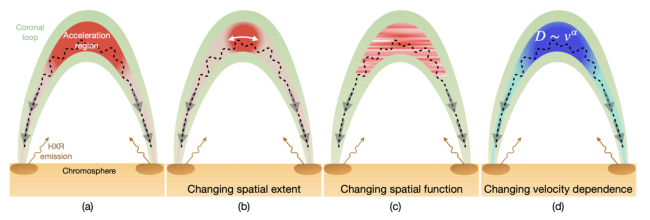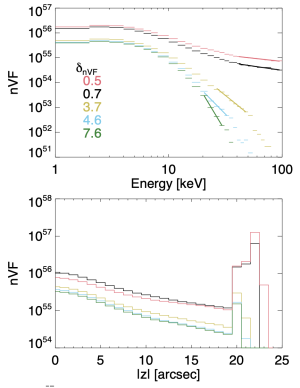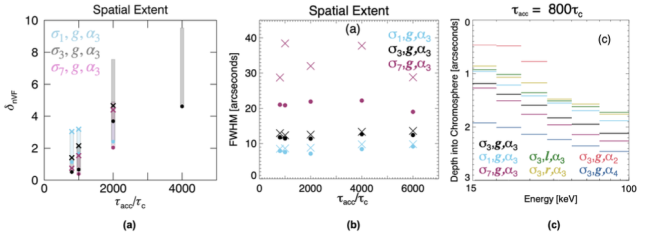Diagnostics of Spatially-Extended Turbulent Acceleration and Transport
| Nugget | |
|---|---|
| Number: | 448 |
| 1st Author: | Morgan STORES |
| 2nd Author: | |
| Published: | April 24, 2023 |
| Next Nugget: | Non-thermal tail plasma |
| Previous Nugget: | RHESSI's Re-entry |
Introduction
Solar flares are effective particle accelerators, with as much as 10-50% of up to 1033 ergs of energy re-leased from the magnetic field contributing to accelerating particles to energies greater than 20 keV. However, the properties and location of the acceleration region is largely unknown, with several competing theories of the acceleration mechanism, including our special interest in acceleration by turbulence. The hard X-ray imaging spectroscopy abilities of RHESSI and now STIX have provided spatially resolved X-ray spectra from bremsstrahlung-emitting electrons accelerated during flares.
Previous observations suggest that turbulence may not be localised in one small region of the corona. Ref. [1] showed the importance of accounting for a spatial variation in turbulence, finding substantial differences from the so-called "leaky box" models (e.g., Ref. [2]).
Modeling
We have now performed a detailed parameter study examining how the presence and varying properties of a spatially-extended turbulent region in the corona changes the spectral and spatial (imaging) properties of observed flare-accelerated electrons deduced from X-ray imaging spectroscopy.
We use a time-independent Fokker-Planck equation to describe the evolution of an electron flux spectrum. The Fokker-Planck equation used accounts for both stochastic acceleration and isotropic scattering, plus collisional transport through a warm coronal plasma. To allow the evolution of an electron distribution to be modelled in space, energy, and pitch-angle to the guiding magnetic field, the Fokker-Planck equation is converted into a set of time-independent stochastic differential equations. For our simulations, we are accelerating electrons out of a thermal distribution and studying how the changing properties of a turbulent acceleration region affects the observed electron properties (Figure 1). We study properties such as the acceleration time (acc), the size (spatial extent) of the acceleration region, and how the turbulence is spatially distributed within the region (spatial function) as well as how the acceleration diffusion (D) is related to velocity of the electrons (velocity dependence). In total we modeled 35 acceleration environments, both with and without the addition of short-timescale turbulent scattering.

X-ray Spectral and Imaging diagnostics
We produce outputs for the density-weighted electron spectrum nVF [electrons/(s cm2 keV)], a quantity that is directly linked to X-ray observations without making assumptions about transport processes occurring in the corona. Figure 2 shows one example simulation output: nVF vs. energy E and position Z for a range of assumed acceleration time durations.

During this work we looked at several useful spectral and imaging diagnostics. Spectral diagnostics include the full flare spectral index δnVF, Figure 3a, which generally decreased as the amount of acceleration in the coronal loop increased. Figure 3 also shows the expected relationship between footpoint and looptop spectra, with the footpoints having steeper spectra.

Imaging diagnostics include the full width at half maximum (FWHM) of the coronal loop, which was determined by fitting a Gaussian distribution to the loop. As shown in Figure 3b, when the spatial extent of the acceleration is changed we see big differences in the FWHM.
The usefulness of several diagnostics depended on the amount of background thermal emission. For example, the ratio of emission in the loop top to the footpoints, is not a reliable diagnostic when the background thermal component is large. When it is small, the ratio is useful for constraining multiple properties: the velocity dependence, spatial extent, and spatial function of the acceleration region.
In order to avoid the effects of a large background thermal component, diagnostics confined to the chromosphere were also studied, for example the mean electron depth in the chromosphere with energy, see Figure 3c. Acceleration region properties change the depth which electrons reach in chromosphere, where the more acceleration there is in the coronal loop, the further into the chromosphere the electrons deposit their energy.
Conclusion
This study models an extended turbulent acceleration region in a solar flare, and shows how the resulting observables depend upon parametrized properties of the region: acceleration and scattering times, spatial extent, the spatial distribution of turbulence, and the velocity dependence of the diffusive transport. This aims at helping the interpretation of future hard X-ray imaging spectroscopic observations. As described in Ref. [3], the different observables taken together can further constrain the properties of the acceleration region.
References
[1] "Spatially inhomogeneous acceleration of electrons in solar flares"
[2] "Determination of Stochastic Acceleration Model Characteristics in Solar Flares"